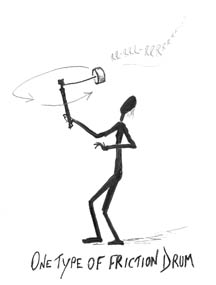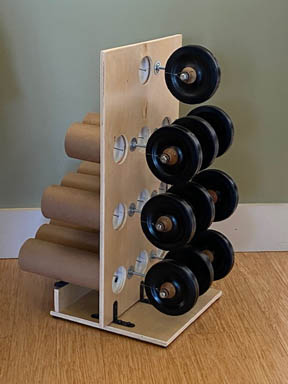 Friction drums: there are many different sorts of instruments that can be called by this name. One sort consists of a tiny drum with a string attached to the middle of the drumhead, with the other end looped around one end of a short stick. If you hold the stick and whirl the drum on its string, a stick-slip pattern sets up at the location where the loop rotates around the stick. The resulting vibration is transmitted through the string back to drumhead, which functions as a soundboard. The inside of the little drum body adds a bit of air resonance. The result is an ear-catchingly buzzy sort of tone. For this to work the string loop should ride in a shallow groove near the end of the stick (to prevent it from flying off), and it helps to have a bit of rosin on the groove. Where this instrument originated I do not know. In a bygone era it could often be found as a children’s toy, but we see it less often now. On the one that I have the drum is about two inches in diameter and two inches high, and the string is about 14” long. The drumhead is some sort of thin animal skin – a nice throwback to older times – but the string is monofilament nylon.
Friction drums: there are many different sorts of instruments that can be called by this name. One sort consists of a tiny drum with a string attached to the middle of the drumhead, with the other end looped around one end of a short stick. If you hold the stick and whirl the drum on its string, a stick-slip pattern sets up at the location where the loop rotates around the stick. The resulting vibration is transmitted through the string back to drumhead, which functions as a soundboard. The inside of the little drum body adds a bit of air resonance. The result is an ear-catchingly buzzy sort of tone. For this to work the string loop should ride in a shallow groove near the end of the stick (to prevent it from flying off), and it helps to have a bit of rosin on the groove. Where this instrument originated I do not know. In a bygone era it could often be found as a children’s toy, but we see it less often now. On the one that I have the drum is about two inches in diameter and two inches high, and the string is about 14” long. The drumhead is some sort of thin animal skin – a nice throwback to older times – but the string is monofilament nylon.
The stick-slip mechanism is remarkably dependable: it never seems to fail in producing a good friction tone when you whirl it. Since I have long had an interest in musical friction systems, I decided to give this one a go. With other friction systems I’ve explored, no matter how wonderful their sounds may be when they work well, there’s always a tendency to be temperamental – an unwillingness to speak if conditions aren’t just right – so the idea of a system that to works more dependably appealed to me.
My thought was to employ some version of this idea not with whirling, but with direct hand-controlled rotation, such as hand-turning a wheel with the string looped around it. This would allow more refined control of articulation; also it would make it easy to set up and play multiple little drums. The hoped-for result was to be a set of easily turned wheels activating strings attached to drum heads which would produce a scale’s worth of pitches. And that is indeed what I ultimately ended up with, but it took some doing to get there. The finished instrument is called Spools & Wheels; you can see and hear it here, and the rest of this writing will be devoted to describing it.
I used 5” rubber wheels, easily manipulated by the hands, as the main manual interface. Attached alongside each wheel, rotating on the same axle, is a suitably sized wooden thread spool, and it is around this spool that the string loops. The spools provide a nice friction surface of about the right diameter. The drums are sections of 3” cardboard mailing tubes cut to varied lengths, and the drumheads are the plastic end caps that are supplied with the tubes. This component – the drumhead or diaphragm – is critical. The choice of material and thickness greatly influences the sounding result. It was by luck that the mailing tube caps turned out to work best among the many materials I tried. We have yet to see how long they will last, but if they do not last well they will be easy and cheap to replace. As you can see in the photo, the wheel-spool-string-drum assembles – ten of them – are mounted horizontally on an upright support board.
During the experimental phase in exploring this instrument, I had lots of ideas about how to lock in the pitch of each drum as clearly and dependably as possible. Many parts could conceivably influence or contribute to the sounding pitch: the mailing tube with its internal air resonance; the diaphragm (tube end stopper) with its natural frequency as modulated by some degree of tension from the string; the string itself, likewise under some degree of tension; and the string-on-wood friction system with its stick-slip frequency. My hope was to get at least a couple of these in agreement with each other so that the agreed-upon frequency would dominate the sound and give the ear a nice clear sense of pitch. For instance, it seemed possible that through careful tuning of the string tension and perhaps some doctoring of the membrane, the membrane and string could not only be put in agreement with each other, but would also then be dominant enough to impose their joint frequency on the stick-slip mechanism. (This would be similar to the way a violin string imposes its natural frequency on the stick-slip happening where bow meets string.) The air resonance frequency of the mailing tube could then also be deliberately tuned to agree with the string-membrane-friction frequency.
A glorious conceptualization! – which was not to be. For various reasons it just wasn’t practical to make each of these components sufficiently tunable to put them all in agreement. But what I found was that even when these several components are not all in agreement frequency-wise, the air resonance tone comes through with a lot of power and clarity, dominating the sound. This alone is enough to provide a sense of pitch. Thus, the instrument produces recognizable pitches and scales based on the lengths of the mailing tubes. Lots of other pitch elements are present in the sound too, of course. Most notably, the stick-slip frequency, which seems to feel no obligation to go along with the program, can often be heard in the tone, moaning along at whatever irrelevant frequencies it favors.
The finished instrument does, as hoped, speak very dependably, and with a tone quality much reminiscent of its whirled progenitor. All in all it’s a nice, odd-looking, reasonably ergonomic, respectably loud instrument of very distinctive tone. More info & audio here.
